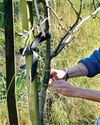
THE two types of begonia are the fibrous-rooted, which tend to be the short-lived bedding varieties, and tuberous. Some fibrous types may actually go on to form a tuber if they live long enough. Botanically, this root structure is actually a corm and it is a means of food storage to help it survive through the winter, but it is generally referred to as a tuber.
Tuberous are best
Tuberous begonia species are typically the ones that produce fabulous displays as summer bedding or in a cool greenhouse, with flowers the size of a plate in some cases. You will often see these varieties and cultivars displayed in classes on the benches at both local and national flower shows, (see picture above), where they draw gasps of admiration from visitors.
Care and storage
If properly stored over winter in a dry, frost-free place, tuberous begonias can be brought back to life in spring and will grow happily for many years. If the plant is well cared for with regular water and food, the tuber will increase in size over time to support the plant as it, too, gets bigger and stronger.
Most of these plants are easy to propagate in a number of ways, according to your preference. You can take leaf petiole or softwood stem cuttings, or the tuber can be divided. Some can also be propagated from seed, but this is often costly and the seed itself is finer than dust, so it is not for the faint-hearted.
هذه القصة مأخوذة من طبعة February 12, 2022 من Amateur Gardening.
ابدأ النسخة التجريبية المجانية من Magzter GOLD لمدة 7 أيام للوصول إلى آلاف القصص المتميزة المنسقة وأكثر من 9,000 مجلة وصحيفة.
بالفعل مشترك ? تسجيل الدخول
هذه القصة مأخوذة من طبعة February 12, 2022 من Amateur Gardening.
ابدأ النسخة التجريبية المجانية من Magzter GOLD لمدة 7 أيام للوصول إلى آلاف القصص المتميزة المنسقة وأكثر من 9,000 مجلة وصحيفة.
بالفعل مشترك? تسجيل الدخول

To dig or not to dig?
Should we be carrying out a full dig on plots now? Bob considers the pros and cons of the 'autumn dig' debate

The box ball blues
As if his beleaguered box hadn't already taken a beating, Toby now has to deal with some hungry box caterpillars

Save your own seeds
Masterclass on: seed saving

Strange sightings
Three unusual insects turn up in Val's garden in one day

A bolt from the blue!
Cornflowers are perfect for garden and vase

Winter moth prevention
Ruth shows you how to avoid maggoty tree fruits

Create a winter container
There are as many options as in summer

Lightweight gardening tools
AS well as being good for our mental health, gardening is also great exercise.

Autumn price round-up
AG finds better bargains in lesser-known brands

Rudbeckias
Rudbeckias are ideal for sunny summer patios and borders, with some able to survive our coldest winters